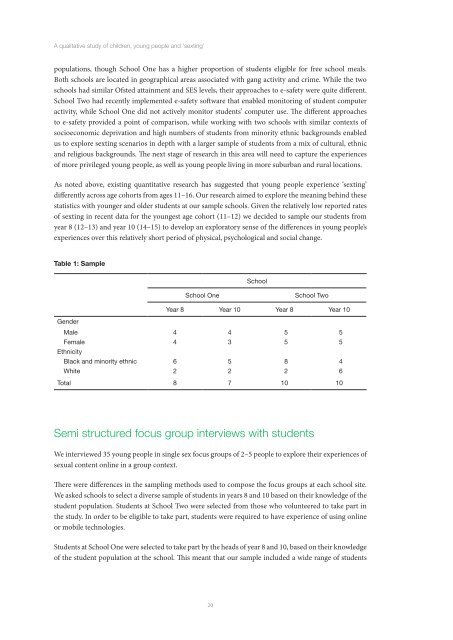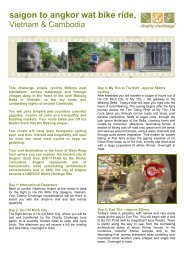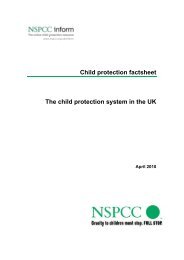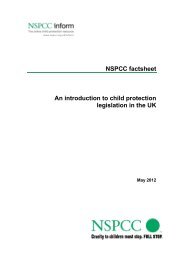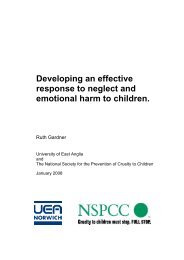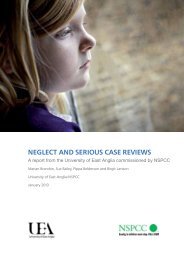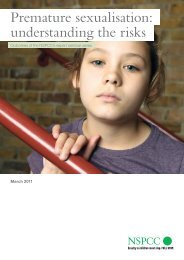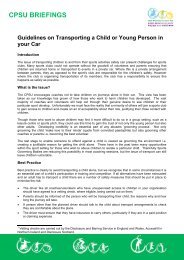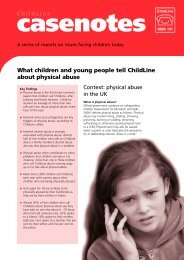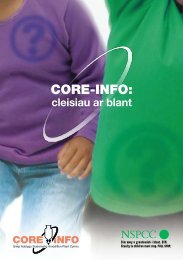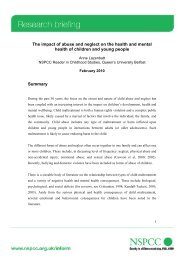A qualitative study of children, young people and 'sexting ... - NSPCC
A qualitative study of children, young people and 'sexting ... - NSPCC
A qualitative study of children, young people and 'sexting ... - NSPCC
You also want an ePaper? Increase the reach of your titles
YUMPU automatically turns print PDFs into web optimized ePapers that Google loves.
A <strong>qualitative</strong> <strong>study</strong> <strong>of</strong> <strong>children</strong>, <strong>young</strong> <strong>people</strong> <strong>and</strong> ‘sexting’<br />
populations, though School One has a higher proportion <strong>of</strong> students eligible for free school meals.<br />
Both schools are located in geographical areas associated with gang activity <strong>and</strong> crime. While the two<br />
schools had similar Ofsted attainment <strong>and</strong> SES levels, their approaches to e-safety were quite different.<br />
School Two had recently implemented e-safety s<strong>of</strong>tware that enabled monitoring <strong>of</strong> student computer<br />
activity, while School One did not actively monitor students’ computer use. The different approaches<br />
to e-safety provided a point <strong>of</strong> comparison, while working with two schools with similar contexts <strong>of</strong><br />
socioeconomic deprivation <strong>and</strong> high numbers <strong>of</strong> students from minority ethnic backgrounds enabled<br />
us to explore sexting scenarios in depth with a larger sample <strong>of</strong> students from a mix <strong>of</strong> cultural, ethnic<br />
<strong>and</strong> religious backgrounds. The next stage <strong>of</strong> research in this area will need to capture the experiences<br />
<strong>of</strong> more privileged <strong>young</strong> <strong>people</strong>, as well as <strong>young</strong> <strong>people</strong> living in more suburban <strong>and</strong> rural locations.<br />
As noted above, existing quantitative research has suggested that <strong>young</strong> <strong>people</strong> experience ‘sexting’<br />
differently across age cohorts from ages 11–16. Our research aimed to explore the meaning behind these<br />
statistics with <strong>young</strong>er <strong>and</strong> older students at our sample schools. Given the relatively low reported rates<br />
<strong>of</strong> sexting in recent data for the <strong>young</strong>est age cohort (11–12) we decided to sample our students from<br />
year 8 (12–13) <strong>and</strong> year 10 (14–15) to develop an exploratory sense <strong>of</strong> the differences in <strong>young</strong> <strong>people</strong>’s<br />
experiences over this relatively short period <strong>of</strong> physical, psychological <strong>and</strong> social change.<br />
Table 1: Sample<br />
School<br />
School One School Two<br />
Year 8 Year 10 Year 8 Year 10<br />
Gender<br />
Male 4 4 5 5<br />
Female<br />
Ethnicity<br />
4 3 5 5<br />
Black <strong>and</strong> minority ethnic 6 5 8 4<br />
White 2 2 2 6<br />
Total 8 7 10 10<br />
semi structured focus group interviews with students<br />
We interviewed 35 <strong>young</strong> <strong>people</strong> in single sex focus groups <strong>of</strong> 2–5 <strong>people</strong> to explore their experiences <strong>of</strong><br />
sexual content online in a group context.<br />
There were differences in the sampling methods used to compose the focus groups at each school site.<br />
We asked schools to select a diverse sample <strong>of</strong> students in years 8 <strong>and</strong> 10 based on their knowledge <strong>of</strong> the<br />
student population. Students at School Two were selected from those who volunteered to take part in<br />
the <strong>study</strong>. In order to be eligible to take part, students were required to have experience <strong>of</strong> using online<br />
or mobile technologies.<br />
Students at School One were selected to take part by the heads <strong>of</strong> year 8 <strong>and</strong> 10, based on their knowledge<br />
<strong>of</strong> the student population at the school. This meant that our sample included a wide range <strong>of</strong> students<br />
20


